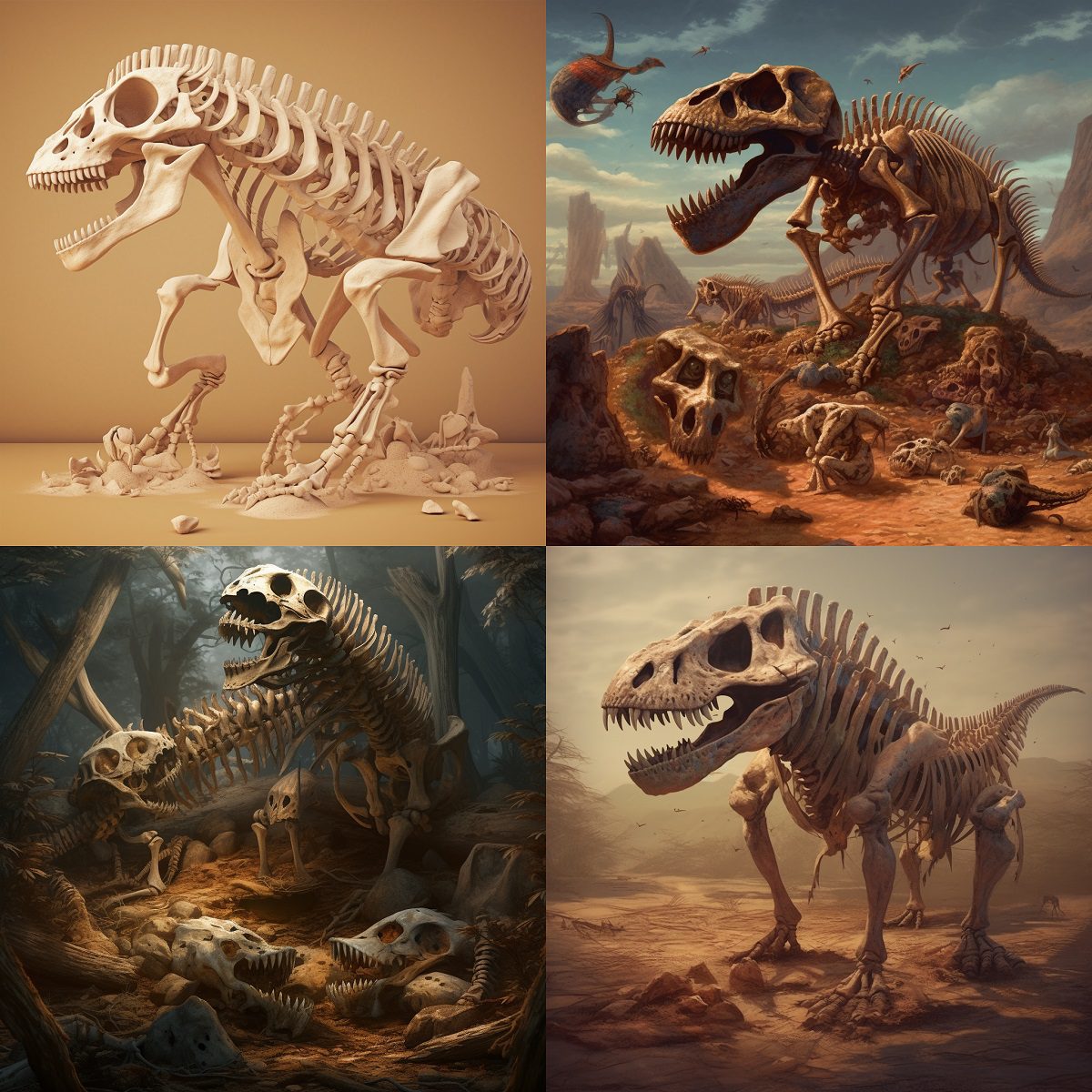
Understanding the fossil formation process is key to unlocking the mysteries of Earth’s ancient past. Fossils offer an exciting look into a bygone era, offering clues to long-vanished creatures and providing invaluable knowledge about their lives.
In this blog post, we will delve deep into various types of fossils, such as unaltered specimens trapped in amber and dinosaur bones preserved through permineralization. We’ll also explore rapid burial’s crucial role in fossil formation and how mineral-rich environments contribute to preservation.
As we examine the intricacies of interpreting the fossil record, you’ll learn about studying preserved plant materials for ecosystem insights and how footprints can reveal early human ancestors’ behavior. Join us on this captivating journey through time as we unravel the secrets behind one of nature’s most intriguing processes: fossil formation.
Types of Fossils
There are two major categories of fossils that help us understand the history of life on Earth. These include unaltered specimens, which preserve an organism’s original form and texture, and permineralized fossils, where minerals replace organic material to create a detailed replica in stone. In this section, we will explore these fascinating fossil types and their unique preservation processes.
Unaltered Specimens Trapped in Amber
Amber, a natural resin produced by ancient trees millions of years ago, has played a significant role in preserving some incredibly unaltered specimens. When insects or small animals became trapped within the sticky resin before it hardened into amber over time, they were perfectly preserved with all their intricate details intact. This remarkable process allows scientists to study these organisms’ anatomy and learn more about the ecosystems they inhabited.
- Baltic amber: Known for its rich golden color and abundant insect inclusions from around 44 million years ago.
- Dominican amber: Originating from the Dominican Republic, approximately 16-18 million years old, it is famous for its exceptional clarity and diverse range of trapped species.
The Permineralization Process for Preserving Bones
In contrast to unaltered specimens found in amber, permineralized fossils involve minerals replacing organic materials within an organism’s remains over time. The most common type is petrified wood – once-living plant tissues replaced by mineral deposits such as silica or calcite while retaining their original structure. This permineralization process also plays a crucial role in preserving bones, shells, and other hard tissues of ancient animals.
The formation of permineralized fossils typically begins with the organism’s rapid burial in sediment or volcanic ash. Over time, groundwater rich in minerals seeps into the buried remains’ microscopic pores and cavities.
As these minerals precipitate out of solution, they gradually replace the organic material within the remains – ultimately creating a detailed stone replica that can provide valuable insights into an extinct species’ biology and behavior.
- Dinosaur bones: Often preserved through permineralization, their fossilized remains have revealed much about their anatomy, growth patterns, and even diseases they may have suffered from.
- Fossil coral reefs: Permineralized corals offer vital clues to past ocean conditions and climate changes over millions of years.
The types of fossils are numerous and diverse, ranging from unaltered specimens trapped in amber to bones preserved through the permineralization process. Moving on, let us explore how these fossils form by delving into the fossilization process.
Key Takeaway:
The article explains the two major categories of fossils, unaltered specimens, and permineralized fossils. Unaltered specimens trapped in amber preserve organisms’ original form and texture while permineralization involves minerals replacing organic materials within an organism’s remains over time, creating a detailed stone replica that provides valuable insights into extinct species’ biology and behavior.
The Fossilization Process
Fossilization is a rare occurrence that involves specific conditions to preserve ancient organisms’ remains or impressions. Key factors include rapid burial after death, protection from scavengers and decomposition agents, and mineral-rich environments aiding preservation through permineralization or other methods like amber entrapment.
Rapid Burial as a Crucial Factor for Fossil Formation
Burial of an organism’s remains must occur swiftly for fossil formation to be successful, safeguarding the specimen from scavengers, weathering, and decay. This process helps protect the specimen from being destroyed by scavengers, weathering, and decay. Rapid burial can occur in various ways, such as sedimentation due to floods, volcanic ash deposition, or even landslides. The quicker an organism is buried after its death, the higher the chances are for it to become a well-preserved fossil.
- Sedimentation: Floods deposit layers of sediments on top of dead organisms which may eventually turn into fossils.
- Volcanic Ash Deposition: Volcanic eruptions can bury entire ecosystems under thick layers of ash, preserving them for millions of years.
- Landslides: Sudden movements in Earth’s crust can cause large amounts of soil and rock to cover plants and animals quickly enough for their remains to be preserved as fossils.
Role of Mineral-Rich Environments in Preservation
A crucial factor contributing to successful fossil formation is having a mineral-rich environment surrounding the buried organism. These minerals play a significant role in preserving organic material over time through processes like permineralization – where minerals replace organic matter within cells creating detailed replicas in stone – and amber entrapment, where organisms are preserved in tree resin that eventually hardens into amber.
Some examples of mineral-rich environments include:
- Limestone and dolomite deposits: These sedimentary rocks often contain a high concentration of calcium carbonate or magnesium carbonate, which can aid in the preservation process.
- Silica-rich environments: Silica is a common component of sandstone and other sedimentary rocks. It plays an essential role in preserving plant material through permineralization and creating petrified wood fossils.
- Tar pits: Natural asphalt seeps trap animals, insects, and plants within their sticky substance. Over time, these remains become encased in layers of sediments, forming well-preserved fossils.
Understanding the fossilization process allows us to appreciate the rarity and significance of each fossil discovered by scientists. By studying these ancient remnants from our planet’s history, we gain invaluable insights into Earth’s past ecosystems and life forms that once inhabited it.
Fossilization is an intricate process, yet its results have been invaluable in helping us understand our planet’s history and the behavior of early humans. Interpreting the fossil evidence can give us insight into how old ecosystems operated and what sorts of activities early humans could have done.
Key Takeaway:
Fossilization is a rare process that requires rapid burial, protection from scavengers and decomposition agents, and mineral-rich environments. Sedimentation due to floods or volcanic ash deposition can bury organisms quickly enough for their remains to be preserved as fossils.
Mineral-rich environments such as limestone deposits or tar pits aid in the preservation of organic material through permineralization or amber entrapment, creating detailed replicas in stone or petrified wood fossils, respectively.
Interpreting the Fossil Record
By studying various types of fossils, such as permineralized wood, insects trapped in amber, and footprints left behind by ancient hominins, scientists can paint a picture of what life was like millions of years ago. This information helps researchers reconstruct ecosystems and understand evolutionary processes over time.

Studying Preserved Plant Materials for Ecosystem Insights
Fossils offer invaluable insights into past ecosystems, enabling us to better comprehend the environmental conditions that shaped our planet’s history. For instance, permineralized plant materials, such as fossilized wood or leaves, provide clues about climate patterns and vegetation distribution during different geological periods.
By analyzing these preserved specimens’ physical characteristics (e.g., growth rings), scientists can infer details about temperature fluctuations and precipitation levels throughout Earth’s history.
- Growth Rings: The presence of growth rings in fossilized wood indicates seasonal variations in temperature or rainfall that affect tree growth rates.
- Fossil Leaves: Leaf size and shape reveal adaptations to specific environments – for example, large leaves are indicative of high humidity levels, while small leaves suggest drier climates.
Footprints Revealing Early Human Ancestors’ Behavior
In addition to preserved organic remains like bones or plants, trace fossils – including tracks left by early human ancestors – serve as essential evidence for understanding their behavior patterns. The Laetoli footprints, found in Tanzania, are a renowned example of trace fossils that give us insight into the activities of hominins from 3.6 million years ago.
These footprints reveal that our ancestors were already walking upright on two legs (bipedalism), an essential milestone in human evolution. Moreover, studying the size and spacing of these prints allows researchers to estimate individuals’ height and weight while also shedding light on their social dynamics – such as whether they traveled alone or in groups.
Key Takeaways from Fossil Record Interpretation
- Fossils offer invaluable insights into past ecosystems, climate patterns, and vegetation distribution throughout Earth’s history.
- Permineralized plant materials like fossilized wood or leaves can help scientists infer details about temperature fluctuations and precipitation levels during different geological periods.
- Trace fossils such as footprints left by early human ancestors serve as essential evidence for understanding their behavior patterns and evolutionary milestones (e.g., bipedalism).
In essence, interpreting the fossil record is crucial for reconstructing ancient environments and piecing together life’s complex evolutionary journey over millions of years. By examining preserved remains – be it permineralized plants or trace fossils like footprints – we continue to unravel mysteries surrounding our planet’s rich natural heritage.
Key Takeaway:
Studying fossils like permineralized wood, insects trapped in amber, and footprints left by ancient hominins helps scientists understand the natural world’s evolution.
Fossils offer valuable insights into past ecosystems, climate patterns, and vegetation distribution throughout Earth’s history. By examining preserved remains, we continue to unravel mysteries surrounding our planet’s rich natural heritage.
FAQs in Relation to Fossil Formation Process
What are the processes of fossil formation?
Fossil formation involves several processes, including unaltered preservation in amber, permineralization for bones, rapid burial to protect remains from decay and scavengers, and mineral-rich environments that aid in preservation. Additionally, studying preserved plant materials and footprints can provide insights into past ecosystems and behavior.
What are the 5 steps of fossilization?
The five key steps of fossilization include
- death of an organism;
- rapid burial to prevent decomposition;
- sedimentation covering the remains;
- a mineral replacement or permineralization where minerals fill spaces within organic material; and
- erosion or excavation revealing the preserved fossils.
These steps may vary depending on specific conditions.
How is a fossil formed in four steps?
A simplified version of fossil formation consists of four main stages:
- death and deposition – an organism dies and settles onto sediment or soil;
- burial – sediments accumulate over time, covering the remains;
- Diagenesis – chemical changes occur under pressure transforming organic material into rock-like structures through mineral replacement or permineralization; and
- exposure and erosion – wear away layers, revealing the fossil.
Conclusion
In conclusion, the fossil formation process is a fascinating topic that reveals insights into ancient ecosystems and early life forms. Various types of fossils can be studied, from unaltered specimens trapped in amber to permineralization processes for preserving bones. Rapid burial and mineral-rich environments play crucial roles in preservation, while preserved plant materials and footprints provide valuable information about past behavior.





























































